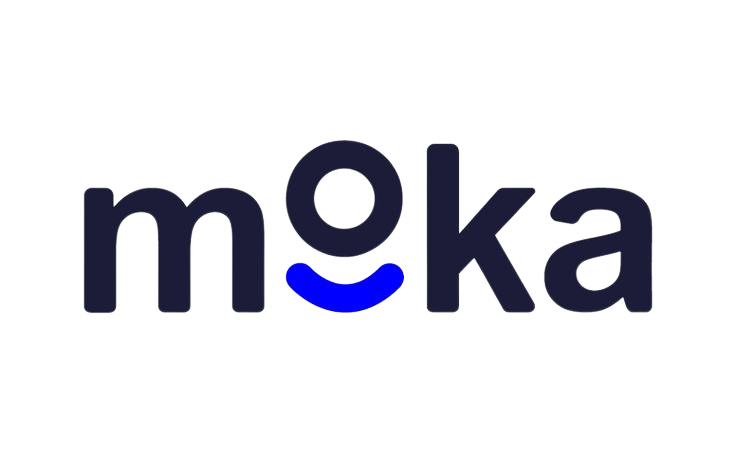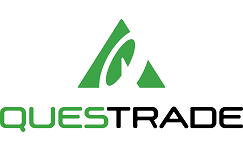A robo advisor is perfect for the passive, set-it-and-forget-it investor.
The platforms are all online, providing automated financial planning and investments based on algorithms with little or no supervision from you (who may be prone to human error).
Let's compare these robo advisors by their fees because most of their portfolios (what stocks and ETFs the robots buy on your behalf) are nearly identical.
Summary of the best Canadians robo advisors
| Canadian robo advisor | Fees | Get started |
|---|---|---|
| Moka |
Monthly subscription fee:
$7 to $15 Management fees The ETFs in Moka's portfolios range from 0.09% to 0.39% |
Get started |
| Wealthsimple |
Average management expense ratio (MER)
0.4% to 0.5% Management fees ◦ 0.50% up to $100,000 ◦ 0.40% once you pass $100,000 |
Get started |
| Questwealth |
Average management expense ratio (MER)
0.19% Management fees: ◦ 0.25% on $250 to $100,000 ◦ 0.20% once you pass $100,000 |
Get started |
| JustWealth |
Average management expense ratio (MER)
0.20% Management fees: ◦ 0.50% on your first $500,000 ◦ 0.40% once you pass $500,000 |
Get started |
| BMO SmartFolio |
Average management expense ratio (MER)
0.20 to 0.35% Management fees: ◦ 0.70% on your first $100,000 ◦ 0.60% on $100,000 to $250,000 ◦ 0.50% on $250,000 to $500,000 ◦ 0.40% on everything over $500,000 |
Visit site |
So, let's talk about the fees that come with robo advisor accounts. Don’t worry —i t’s not as complicated as it sounds.
Management expense ratio fees. Think of it as the cost for having your investments handled for you. Essentially the robot is balancing your portfolio, based on your risk tolerance, and buying and selling ETFs on your behalf for the greatest gain. It’s usually around 0.5% of your account balance if you’re starting with a smaller amount. The more cash you have invested, the lower the expense ratio. You can avoid these fees if you start investing on your own.
Related: How to buy ETFs
Management fees. These are what you pay when your money is invested in ETFs (Exchange-Traded Funds), they are unavoidable even if you're investing on your own. These fees are baked into the returns of the ETFs. Basically, you’re getting slightly less money back because the fees are subtracted before you see your returns.
Related: Investing for beginners
Trading commissions might come up too, but don’t stress—most robo advisors include this in the advice fee, so it’s not something you pay separately.
All told, a typical robo advisor will cost you somewhere between 0.5% and 0.8% of your investment each year. It might sound like a lot, but it’s way less than what a traditional investment advisor, like Edward Jones, might charge, and you’re getting a pretty solid service for that money.
With very few exceptions, the fee structure of most robo advisors in Canada is based on a percentage structure, meaning that you pay a percent of your total overall investment portfolio to the robo-investing company each month. So, no matter how your portfolio performs, you’re giving the company a percentage of your investments each month.
Moka is different. Moka's unique model means that unlike other robo advisors where the fee you pay is a percentage of the net worth of your investment portfolio, Moka charges a flat fee of $15, per month. So whether you’ve invested $100 or $100,000 with Moka, you’ll only be charged this low monthly fee.
This pricing model is especially appealing to those with smaller investment portfolios. By offering a low, flat fee, Moka makes it feasible for almost anyone to start investing, regardless of their initial capital.
This accessibility may be especially appealing to first-time investors who don’t feel comfortable paying a percentage of their portfolio to an investment company no matter how well (or poorly) their investments are doing. It may also be a good choice even for enthusiastic investors with an extensive investment portfolio because you’ll pay much less in fees.
For example, if you have an investment portfolio of $100,000 and are paying a fee of 0.5%, you’d pay approximately $500 a year in fees, but with Moka, you’d pay only $84, which is a significant saving.
A decade ago, investing felt like a major hassle for most Canadians. You had to meet with advisors in person, do tons of research, and there wasn’t much reliable info online. But robo advisors have changed all that, making investing simpler, faster, and more affordable.
Robo advisors handle the hard work for you. They invest in ETFs, which lowers the risk compared to picking individual stocks. That means less stress and more stability, without feeling like you’re gambling in the stock market.
Plus, you save on fees. Robo advisors cost much less than traditional financial planners, and because the process is automated, you don’t have to pay for expensive, one-on-one advice. These savings get passed down to you, making investing more budget-friendly and efficient.
Of course, there are now so many robo advisor options out there for Canadians to choose from. And not all are created equal. You’ll need a robo advisor that offers education, high security, low fees, ease of use but also a solid strategy to reach your goals. So what’s the best option for you? Let’s get to it.
Best robo advisor for beginners or passive investors
- Management fees: 0.5% for basic deposit, 0.4% after you have $100,000 invested
- Minimum account size: No minimums
If you’ve looked into online investing, Wealthsimple is likely one of the first options to come up. It was the first robo-advisor on the scene here in Canada, and continues to maintain its place as the top choice among Canadian investors.
If you’re looking for a user-friendly investment tool with little human interaction, that’s Wealthsimple. The investment will build wealth slowly over time, choosing amongst eight to 10 exchange-traded funds (ETF) to get you there. You simply have to choose which portfolio you’d like: conservative, balanced or growth.
From there, you can select where you’d like to place your investments, whether it be a Registered Retirement Savings Plan (RRSP), Tax-Free Savings Account (TFSA), or others. Further, you can choose whether your investments are halal, socially responsible, focused on human rights or other areas important to you.
As for plans, you have a choice between Core, Premium and Generation accounts.
Core ($1-$99,999 invested) includes auto-rebalancing, auto-deposits and expert advice.
Premium requires a deposit of $100,000 or more, and gives you access to financial planning sessions, tax-loss harvesting and tax-efficient funds.
Generation requires a deposit of $500,000 or more and comes with all of Premiums's features. Generation also adds a team of advisors, and personalized financial reports. With the company constantly updating its research for users, it does seem that Wealthsimple has something for everyone.
Best robo advisor for investing long-term
- Management fees: $7 to $15 per month (plus 0.09% to 0.39% fees for the ETFs)
- Minimum account size: No minimums
Moka stands out in the investment world with its streamlined, effective approach. It's designed for hassle-free investing, automating contributions to the S&P 500, known for its solid average annual return of 10% over 65 years. This makes Moka ideal for those seeking long-term growth without the need for active management.
Monthly subscription fee:
Basic Plan: $7 per month. This plan includes automated saving features, unlimited tax-free investment accounts, and access to socially responsible investment portfolios. Money
Moka 360 Plan: $15 per month. This plan offers additional features such as financial coaching, debt repayment tools, and enhanced cashback perks.
However, its focus on the S&P 500 might be limiting for those wanting a more diversified, global portfolio. Additionally, the automated approach might not satisfy active investors who prefer hands-on portfolio management.
Moka's flat monthly fee structure can be advantageous for those with larger account balances, as the fee remains constant regardless of the amount invested. However, for smaller accounts, the flat fee may represent a higher percentage of your investment.
Despite these limitations, Moka's appeal lies in its simplicity, low cost, and commitment to environmental causes, making it a compelling choice for investors who value ease and efficiency over complex investment strategies. It’s a particularly attractive option for beginners or those who prefer a 'set and forget' investment approach. With Moka, investing in your future is just a few clicks away, making it a worthy contender for anyone looking to grow their wealth effortlessly.
Best robo advisor for low fees: Questwealth
- Management fees: 0.25% first $100,000, 0.20% after that, plus administrative fees based on which account chosen for investment.
- Minimum account size: $1,000
Another heavy hitter within the robo-advisor world is Questwealth. The company came on the scene back in 1999 as a low-cost investment option, and that’s translated over to its robo-advisor platform. While it’s not entirely automated, the fees remain the most competitive out there.
The setup is simple. After filling out a questionnaire on your risk level, you are then placed into a portfolio category of either aggressive, growth, balanced, income or conservative. Then you choose the type of account you want to invest in, such as a TFSA or RRSP.
Also similar to other robo-advisors, the company chooses a passive investing approach for long-term, stable growth. However, they also use humans to buy and sell securities and rebalance portfolios. This is where some have argued the company drifts away from passive investing. However, it could also just be light interaction, far less active than mutual funds.
Best robo advisor for new investors
- Management fees: $4.99/month, $2.50/month for RESP, plus 0.5% annual fee and average 0.25% ETF fee
- Minimum account size: $5,000, no minimum for RESP
Similar to other robo advisors, Justwealth is not completely automated. In fact, the company prefers to see themselves as more personal, with a hybrid approach that combines humans to talk to along with automated investing options. Therefore, this might be a great option for those nervous about an algorithm running their finances.
The main difference with Justwealth, however, is that they have 70 different portfolios. The main categories are global growth, Canadian growth, income, socially responsible, educational target dates and USD. With those are even more portfolios for those who like options.
Because it does have an entire area dedicated to education, some argue that this is the best option for those wanting to invest in a Registered Education Savings Plan (RESP). You can simply choose a target date and investment strategy and let Justwealth do the rest. The main downside is you do have to have at least $5,000 to start, and it costs $50 to $150 to transfer out cash.
Best robo advisor of the big banks
- Management fees: 0.7% first $100,000, 0.6% next $150,000, 0.5% next $250,000, 0.4% above $500,000.
- Minimum account size: $1,000
Now it’s not just independent companies and financial institutions that have gotten into the robo advisor game. It’s also the Big Six Banks. However, among the big banks, it looks like the BMO Smartfolio remains the leader in the pack.
The reason probably comes down to being the first of the big banks to offer a robo advisor program. They also offer a hybrid option where you can meet with advisors through Skype, online chat, phone or in person. There is also access to algorithmic rebalancing features for your portfolio.
Now BMO SmartFolio wouldn’t label themselves a robo advisor because it does offer a team of managers that adjust regularly based on market conditions. It has five portfolio managers and eight credited financial analysts focusing on ETFs that provide global and diversified exposure. This is monitored on a daily basis.
Yet, like CI Direct Investing, BMO’s more active approach leads to higher fees. While accounts can be grouped by household to reduce fees and pricing, it’s still relatively costly. Plus, these don’t take into account ETF fees of between 0.2% and 0.35%.
A robo-advisor is an automated investment service that runs on algorithms — rather than human beings — to build, manage, and invest your portfolio.
Since the algorithms don’t require the same hands-on attention as using a financial advisor, robo-advisors only charge a fraction of the fees that you would pay for human professionals to actively manage your account. In addition, many robo-advisors have low or no minimum investment requirements, making them more accessible to the average person. That being said, there are still professional advisors in the background available to help if needed.
One of the biggest draws of robo advisors is they allow a very hands-off style of investing. This makes them ideal for those who want to follow the “set it and forget it,” or couch potato, strategy. There are also different levels of risk tolerance, allowing you to personalize your portfolio based on your financial needs and goals.
While the idea of lower management fees is definitely an attractive one, some individuals hesitate over the idea of a robo-advisor because of security concerns. Which leads to the question: Are robo advisors safe?
It’s important to remember that a robo advisor is still an investment tool. No investment is ever “safe,” no matter your level of risk. But, in terms of security and trustworthiness, yes — a robo-advisor is generally safe for investors to use.
Robo-advisors have top security features similar to what you will find at Canada’s online banks. Additionally, many financial management services are members of the Canadian Investor Protection Fund (CIPF) or the Investment Industry Regulatory Organization of Canada (IIROC).
CPIF ensures your money up to $1 million if your robo-advisor goes out of business and IIROC regulates the robo-advisors to ensure they are following best practices.
Mutual funds have been around for over a hundred years, offering professional management and active investing strategies. Meanwhile, robo-advisors use technology to automate investing, focusing on low-cost, passive strategies. Each approach has its pros and cons, and the right choice depends on your investing style and financial goals.
Mutual fund defined
A mutual fund pools money from many investors to buy a mix of stocks, bonds, or other securities. Each fund follows a specific investment strategy — some focus on specific sectors, regions, or asset classes. Mutual funds are actively managed, meaning fund managers make buy-and-sell decisions aiming to beat the market.
Pros and cons of mutual funds
Pros
-
Professional management – Experts actively manage your investments
-
Diversification – Exposure to a broad range of assets
-
Variety – Funds cater to different risk levels and investment goals
Cons
-
High fees – Management expense ratios (MERs) range from 1-3%
-
Inconsistent performance – Many funds fail to consistently beat the market
-
Emotional bias – Human fund managers can make costly mistakes
But wait, there are some low-fee mutual funds in Canada
While traditional mutual funds are expensive, some fund managers offer low-cost active investing alternatives. Two standout options in Canada are Steadyhand and Mawer.
- Steadyhand Founders Fund – MER of 1.34%. Balanced portfolio of stocks and fixed income, with an 11% annualized return since 2012.
- Mawer Balanced Fund – MER of 0.96%. Mix of Canadian, U.S., and international equities and bonds, with a 7.2% annualized return over 10 years.
Mind you, those MERs are 100% more costly than Wealthsimple, and 400% more than Questrade.
Mutual funds vs robo-advisors: What's better for you?
| Mutual funds | Robo-advisors |
|---|---|
| Feature:Human fund managers | Feature: Algorithm-driven investing |
| Investment style: Active (tries to beat market) | Investment style: Passive (tracks the market) |
| Fees: 1-3% MER | Fees: 0.25%-0.50% MER |
| Control: Investors choose funds | Control: Limited customization, (e.g. risk tolerance, ESG or Halal) |
| Performance: Varies, often underperforms | Performance: Matches market trends |
What the data says
According to a 2017 Standard & Poor’s study, over 92% of actively managed large-cap mutual funds underperformed a simple S&P 500 index fund over 15 years. The odds of consistently beating the market? Only 1 in 20.
Which should you pick?
- Choose mutual funds if you want active management and don’t mind paying higher fees.
- Choose robo-advisors if you want low-cost, hands-off investing with market-matching returns.
While Steadyhand and Mawer are among Canada’s best mutual funds, robo-advisors like Wealthsimple and Nest Wealth provide a cheaper, more efficient way to invest. The math is clear—keeping fees low leads to better long-term gains.
How to choose a robo advisor
- Fees: Look for low management fees and MERs to maximize your investment returns.
- Investment options: Check if they offer diversified ETFs, socially responsible investing, or customizable portfolios.
- Ease of use: Choose a platform with a user-friendly app and clear investment insights.
- Customer support: Make sure there’s reliable support if you have questions or concerns.
- Account types: Ensure they support the accounts you need, like RRSPs, TFSAs, or non-registered accounts.
- Performance history: Review their past performance, but remember it’s not a guarantee of future results.
Robo advisor pros and cons
Pros
-
Low fees: Robo-advisors generally cost less than traditional financial advisors.
-
Automated investing: Hands-off approach with portfolios managed for you.
-
Diversified portfolios: Spread out your investments to minimize risk.
-
Accessible: Easy to use, often with low account minimums.
-
Goal-based planning: Tailored to your financial goals and risk tolerance.
Cons
-
Limited customization: Less flexibility in investment choices.
-
No human touch: Personalized advice from a human advisor isn’t included.
-
Market performance: May not outperform the market or active management.
-
Flat fees for small accounts: Fixed fees can be expensive for lower balances.
FAQ

Amy Legate-Wolfe is an investment junkie, who aims to help others get hooked by providing well-researched advice. After receiving a masters in journalism from Western University, Amy worked for Huff Post and CTVNews.ca, while freelancing for organizations such as the CBC, Motley Fool Canada and Financial Post. Amy Legate-Wolfe is an experienced personal finance writer and freelance contributor working with Money.ca.

Tyler Wade has worked in personal finance for over 5 years writing for brands like Ratehub, Forbes, KOHO, and now Money.ca.
Best investing content
How to...
Disclaimer
The content provided on Money.ca is information to help users become financially literate. It is neither tax nor legal advice, is not intended to be relied upon as a forecast, research or investment advice, and is not a recommendation, offer or solicitation to buy or sell any securities or to adopt any investment strategy. Tax, investment and all other decisions should be made, as appropriate, only with guidance from a qualified professional. We make no representation or warranty of any kind, either express or implied, with respect to the data provided, the timeliness thereof, the results to be obtained by the use thereof or any other matter. Advertisers are not responsible for the content of this site, including any editorials or reviews that may appear on this site. For complete and current information on any advertiser product, please visit their website.
†Terms and Conditions apply.









